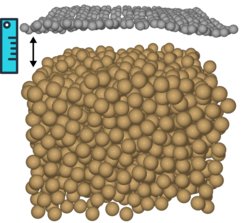When machines just get it right:
Atomic-scale insights into defect-free growth of graphene
High-level synchrotron experiments confirm the sub-atomic precision of a machine-learning based prediction for the adsorption height of graphene at liquid metal catalysts. With such reliability, the AI-approach constitutes a powerful new tool to study the growth process of this much aspired material even under most extreme conditions.

Graphene has properties almost as if out of a picture book. It is simultaneously strong and flexible, it permeates water but filters gases, it is transparent like glass but at the same time conducts current better than a metal – and on top of it all, it is as thin as can be. Graphene consists just of a single layer of atoms. No surprise that interest in this wonder material (Nobel Prize 2010) explodes. Unfortunately, graphene displays all of these properties only when it is essentially defect free, and this is exactly what limits commercial production today.
Recently, highest-quality graphene films could be produced at copper catalysts. The gist was to melt the copper above 1100° degrees, so that the film growth occurs above the liquid metal surface. Yet, why these extreme conditions favor the formation of defect-free graphene is largely unknown. Not least the high temperatures and gas flows during growth hamper gaining the necessary atomic-level insights. Much hope is therefore placed on methods of machine learning that can accelerate highest-accuracy quantum mechanical predictions to a level that allows so-called molecular dynamics simulations to correctly account for the high mobility of atoms at the liquid copper surface. Up to now, there is very little experience as to the reliability of these AI approaches though.
As an important benchmark, scientists at the Fritz Haber Institute (FHI) predicted the height of a growing graphene layer above the liquid copper catalyst using these novel approaches, and compared it against measurements from high-level synchrotron experiments achieved within a European consortium. The result is striking. The machines were right down to 10-11 m, or within less than one millionth the width of a hair. This high precision, called “sub-Ångstrøm“ in the jargon of the field, demonstrates the impressive capabilities of the novel AI approaches to acquire detailed insights into the microscopic growth process. “Our results nicely show the unprecedented possibilities”, summarizes the leader of the FHI-team Dr. Heenen proudly. “Intriguingly, the data on adsorption height suggest an essentially identical chemical interaction of graphene with solid and liquid copper. This renders the superior synthesis above the liquid metal surface even more mysterious.” As so often in science, one question answered raises several new ones – at least with the AI approaches the researchers now have a powerful new tool at hand.












